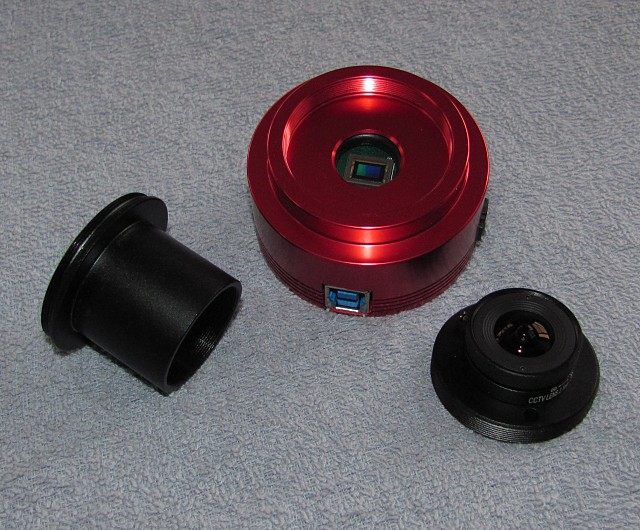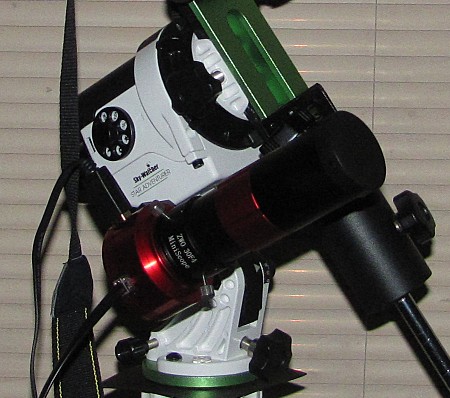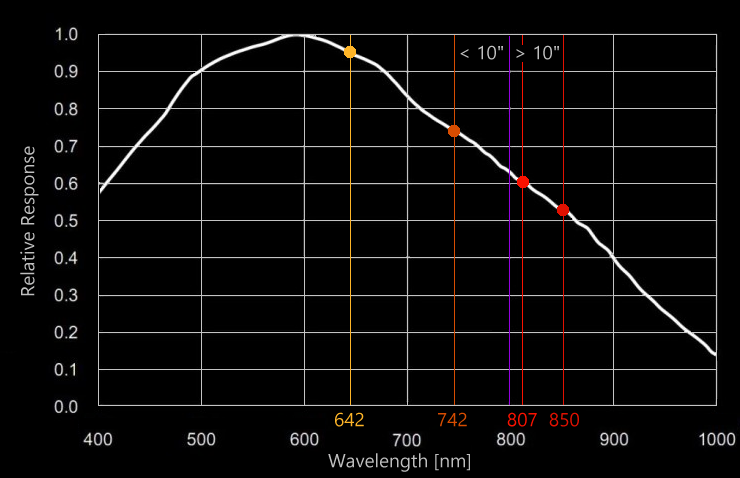Equipment Review (Preliminary)
ZWO ASI290MM
Purchase price: JPY 48,500
Dealer: KYOEI-TOKYO
Conclusion: Breathtaking!
Please appreciate that this review reflects personal impressions and views.

ZWO ASI290MM monochrome CMOS camera with bundled adapter and all-sky lens.

The ASI290MM is tailor-made for autoguiding shown with the ZWO Ø30mm F4 autoguide scope.
The ZW Optical (ZWO) ASI290MM CMOS camera contains a sensitive monochrome sensor with 12-bit ADC capable of recording in 8-bit or 16-bit grayscale. Its extremely well crafted body incorporates a B-type USB 3.0 computer port (control port and power source) as well as an ST4 autoguiding port which connects to a compatible equatorial mount via a straight RJ11 6P6C cable. The ASI290MM sports Sony's back-illuminated IMX290LQR, a 1/2.8″ sensor (5.6mm x 3.2mm, 6.46mm diagonal) with 1936 x 1096 pixels (HD aspect), 2.9µm square. An anti-reflection filter serves as optical window to protect the sensor from dust and scratches. The back focus is 12.5mm. The camera body weighs 120 grams and bundles a simple 2.1mm CCTV lens providing a 150° sky view, which is a nice gesture of ZWO since the camera's sensitivity is well suited for, say, wide field meteor monitoring.
When using 2x binning with the capture software the camera treats 4 pixels as if one, collecting four times more light sufficing with shorter exposures, however, at less detail and halved image size. When imaging small planets, the camera can crop the area it processes thus significantly increase the video frame rate (ROI function).
Although the ASI290MM is not specified for deepsky imaging it is sensitive enough for experiments with bright objects while it can be used with narrowband filters such as Quad Band or Hα. The primary application however is for lunar and planetary imaging, largely because of the small chip.
 A quick experimental image with a Samyang 135mm at f2 and Sightron Quad Band filter, 95 lights x 20 sec, gain 100, 20 darks, 2x drizzled in DSS.
No calibrations applied. It can be done better with more diligence and affection though.
A quick experimental image with a Samyang 135mm at f2 and Sightron Quad Band filter, 95 lights x 20 sec, gain 100, 20 darks, 2x drizzled in DSS.
No calibrations applied. It can be done better with more diligence and affection though.
ZWO provides an USB camera driver as well as its own capture and autoguiding software, ASIStudio, for Windows. Of course, popular capture suites such as SharpCap and FireCapture running on a Windows laptop/notebook PC can be employed.
The ASI290MM surprises with high frame rates even at full image size of 1920 x 1080 pixels, namely up to 170fps with exposure times under 10ms, 10-bit ADC and 8-bit image files. Short exposures at high frame rates help "freeze" turbulent seeing. For both the moon and the planets 8-bit image files are more than sufficient. The camera's noise behavior too is excellent in that the gain can be screwed up to 300 of 600 even when stacking less than 1000 frames (basically, the more the better).
A well thought-out camera. No doubt, the people at ZWO know exactly what they are doing.
When using the bundled CCTV lens, please adjust focus slowly and be sure to not focus beyond infinity because the lens, when screwed in too deep, can scratch the optical window.
Filters
Lunar and planetary photography typically requires a telescope with long focal length in order to obtain sufficient magnification. A telescope with large aperture gathers more light, contrast and detail, but in turn is more affected by turbulent atmosphere. Poor seeing can be compensated for with infrared pass filters since longer wavelengths are less susceptible to air turbulences, but they also sacrifice details. An IR-pass filter trades against exposure time as the sensitivity of CMOS cameras drops significantly at near-infrared. Typical opening wavelengths are from 650nm to 850nm, the longer ones optimal for apertures over 10 inches while filters shorter than 800nm are more suitable for smaller apertures (less prone to poor seeing).
The ASI290MM is most sensitive at 590nm and provides a relatively high infrared response of over 50% at 850nm! For average seeing conditions an infrared pass filter opening at 640nm is an excellent compromise for up to 8 inches aperture with respect to exposure time, details and seeing compensation. You may prefer a 740nm filter if you have a larger scope. After all, quiet and clean air is the best 'filter'.
 Relative response curve of the ASI290MM against IR pass filters.
Relative response curve of the ASI290MM against IR pass filters.
Sample Images
Image stacks taken with the ASI290MM with a Celestron C8 telescope. Captured during good seeing with SharpCap and processed 1.5x drizzled with Autostakkert!3 plus curve adjustment and a high-pass filter applied in Photoshop.
 Celestron C8, ASI290MM, 4ms, gain 200, 250x, 170fps, IR640nm
| Full Screen
Celestron C8, ASI290MM, 4ms, gain 200, 250x, 170fps, IR640nm
| Full Screen
 Celestron C8, 1.6x barlow, ASI290MM, 5ms, gain 150, 600x, 169fps, IR640nm
| Full Screen
Celestron C8, 1.6x barlow, ASI290MM, 5ms, gain 150, 600x, 169fps, IR640nm
| Full Screen
 Celestron C8, 2x barlow, ASI290MM, 7ms, gain 300, 600x, 142fps, IR640nm
| Full Screen
Celestron C8, 2x barlow, ASI290MM, 7ms, gain 300, 600x, 142fps, IR640nm
| Full Screen
 Celestron C8, no barlow, ASI290MM, 7ms, gain 150, 600x, 142fps, IR640nm
| Full Screen
Celestron C8, no barlow, ASI290MM, 7ms, gain 150, 600x, 142fps, IR640nm
| Full Screen
Many further samples in the gallery...
Pros
- Fast frame rate at maximum resolution.
- Awesome resolution for lunar and planetary
- Optimal as autoguider
- Excellent noise performance
- USB 3.0 control interface
- Includes a 2.1mm CCTV lens
- Light weight, solid construction
- Easy sensor access for cleaning
- Comes with intuitive capture software
- Quarter-inch tripod thread
- Bundles all needed adapters and cables
Cons
- The C-adapter ring can get stuck in the thread (two holes are drilled to help get it loose; use wooden sticks). A minor issue.
Wish List
- Dead pixel detection
- Internal buffer memory

